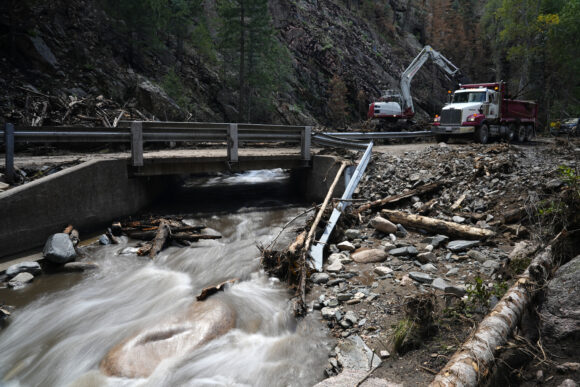ALBUQUERQUE, N.M. (AP) — A measure that would clear the way for New Mexico to provide zero-interest loans to local governments to repair or replace public infrastructure damaged by wildfires or post-fire flooding has cleared its first legislative hurdle.
The bill comes as the arid state recovers from a historic wildfire sparked last year when prescribed fire operations managed by the U.S. government ballooned into a conflagration that charred more than 530 square miles (1,370 square kilometers) of mountainsides and valleys — taking with it hundreds of homes, livelihoods and cultural connections that generations of northern New Mexico families had built with their rural surroundings.
Experts have warned that the environmental consequences will span decades, with one of the most immediate concerns being flooding as snow in the higher elevations begins to melt this spring.
Acknowledging the harm done, Congress and President Joe Biden have approved nearly $4 billion in recovery funds. The Federal Emergency Management Agency is still getting its claims offices up and running in New Mexico and local officials expect it will take time for the aid to trickle down.
Sen. Pete Campos, a Las Vegas Democrat, said his constituents are in dire need.
“The resources by FEMA are slow in coming and it’s not to detract from the institution and the work that they’ve done, but it’s to indicate to the public that there is an urgency,” he told members of the Senate Conservation Committee on Monday.
The legislation would set aside $100 million for counties, cities and municipalities to begin work on projects that could include a water treatment plant in Mora County or roads, bridges and fences in Las Vegas, where thousands of residents were forced to evacuate as the fire approached last spring.
The state Department of Finance and Administration would manage the loan program. The bill does not say how the applications would be considered or approved and does not include a timeline or repayment terms.
Supporters say the state funding would go toward projects FEMA has indicated it will cover under federal guidelines. That means FEMA funds could be used by the local governments later to repay the state loans.
Federal officials have been doing damage control in the months following the Hermits Peak-Calf Canyon blaze, with the U.S. Forest Service resuming operations nationwide after a 90-day pause to review prescribed fire policies and procedures. They have vowed things will be done differently after acknowledging missteps and mistakes were made.
Forest officials said at Monday’s meeting that the landscape has become drier and the weather more unpredictable amid climate change.
Some in the audience echoed those concerns as the committee considered a separate bill that would prohibit prescribed burns by government agencies during New Mexico’s dry, windy season. The measure was tabled, but Republican Sen. Ron Griggs of Alamogordo said something needs to be done to protect residents.
“If we genuinely believe that prescribed burns are not going to cause additional fires in the future, I think we’re kidding ourselves,” he said.
State Forester Laura McCarthy testified that prescribed fire is an invaluable tool and that it would be a disservice to limit the timing of projects given that New Mexico is such a large state, where one area could be dry while another could be covered with snow at the same time.
Mary Kay Root, a volunteer firefighter, fought back tears as she told the committee that she, her sister and her mother all lost their homes. Her home near the base of Hermits Peak was reduced to ashes.
She said there was no consultation by the Forest Service with the local volunteer fire departments.
“Everyone was aware that that was no day to start a fire,” she said. “We already had begun letting people in the canyon know to not go ahead and burn their brush because it was just too windy and far too dry. I hope this kind of thing can be curtailed in the future.”
Top photo: An excavator piles charred debris alongside floodwaters choked with ash at the Gallinas River, on Aug. 9, 2022, in Gallinas, N.M. More than four grueling months and $300 million later, the federal government has declared the largest wildfire in New Mexico’s recorded history 100% contained, a notable milestone but just another step in what local residents and officials say will be a long journey toward recovery. (AP Photo/Brittany Peterson, File)
Was this article valuable?
Here are more articles you may enjoy.


 Survey Shows Distracted Drivers Overconfident: 20% Text While Driving, 15% Use Social Media
Survey Shows Distracted Drivers Overconfident: 20% Text While Driving, 15% Use Social Media  DeepSeek Poses ‘Profound’ Security Threat, US House Panel Claims
DeepSeek Poses ‘Profound’ Security Threat, US House Panel Claims  GSK Zantac Appeal Gets Tough Questions From Some US Judges
GSK Zantac Appeal Gets Tough Questions From Some US Judges  La Niña’s End Threatens to Unleash an Active Atlantic Hurricane Season
La Niña’s End Threatens to Unleash an Active Atlantic Hurricane Season 